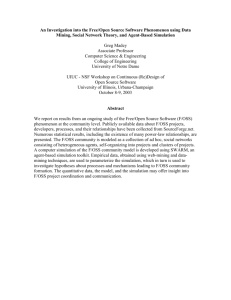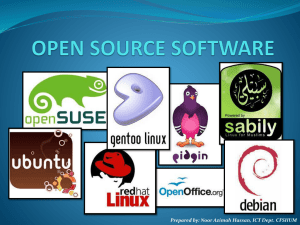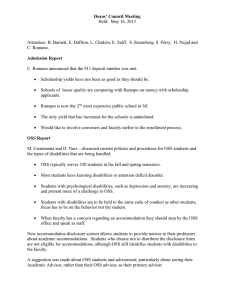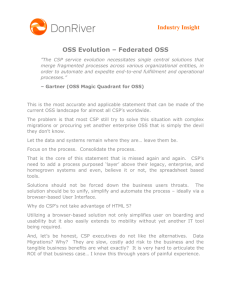OSS Planning and Development in China Lu chuncong
advertisement
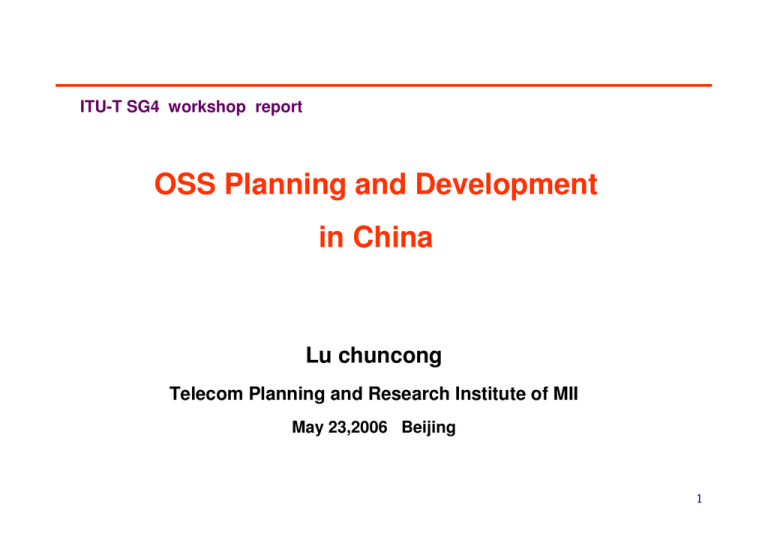
ITU-T SG4 workshop report OSS Planning and Development in China Lu chuncong Telecom Planning and Research Institute of MII May 23,2006 Beijing Vice President of Planning & Research Institute of MII . Vice President of Network Operation & Management Community of CACE. Senior engineer. Graduated From Changchun Posts & Telecommunications Institute in 1994; Obtain MBA In China RenMin University in 2004. Lu Chuncong Tel 010 68034068 13910905692 e-mail: luchuncong@ 163.com luchuncong @ catr.com.cn Fax: 010-68026830 Contents Part1: OSS Definition and Applications Part2: OSS Requirements and Developing Trends In China Part3: OSS Planning Methods Part1: OSS Definition and Applications IT Supporting system In China, IT Supporting System include OSS BSS MSS, which based on Enterprise Level, provide supporting bases for service fulfillment, service assurance and service billing. From the view of human body, IT supporting system is just like the Blood Transmission System which carries nutritious and useful elements to their corresponding destinations. So, if we want to enhance management level ,we must make all departments work orderly and efficiently, the other thing we need is the planning and construction of IT supporting system effectively. IT supporting system has gradually become one of the important factors which indicate the competitive abilities of Tele-operators. Definition OSS is a computer network which integrated Computer, Telecommunications and Network management Technologies. Mainly covers Element Management Layer Network Management Layer realize centralized monitor Service Management Layer in TMN control and management for Telecommunications Networks. The Object of OSS is to make Network operates effectively,reliably and safely OSS is independently from BSS and MSS . Only inter-operate in some degree. OSS meaning In Narrow Sense: Network Management System for One specific Network.. Integration Network Management System for all Networks. In Broad Sense: Electronic Operation & Management System for OA&M.. The coverage of OSS and BSS/MSS within eTom eTom is drived by markets and TMN by Technologies. BSS OSS MSS The theoretically analyses of OSS applications for Network OA&M Def. of OAM ( Operation & Administration & Management): The software, hardware, organization and the related produce activities and management activities to ensure the telecom networks work normally, safely and efficiently. Software produce and mgmt. rules, work flows etc. Hardware computer networks, e.g. OSS, MSS etc. Organization organizations of OAM Logical Network Telecom Network services founding and safeguarding, routes organization, network resources etc. Comprehend OA&M: Network operation mgmt. Network service mgmt. Network resources mgmt. Service monitoring switch network, transmission network, access network, signalling network service network, etc. Monitoring, controlling and directing; Network and service oriented, focus on real-time. Service safeguard Network control Physical Network Operation Network maintenance mgmt. Network elements Administration Maintenance Maintenance, testing and mgmt. of monitoring mgmt. the Equipments O&A Network elements oriented; Faults handling Testing and maintenance daily hardware and software; Supporting the service operations; Not real-time. Relations between Network Operations and maintenance 3rd Layer: OA&M supporting Layer 2nd layer Network Operation Monitoing& controlling Monitoring & Controlling Key responsibilities 1.Network resources mgmt. 2.Network services mgmt. 3.Network performance mgmt. 4.Data mgmt. Monitoring, controlling and directing; Network and service oriented, focus on realtime mgmt. centralized Network mgmt. center 2. Performance analysis gathered; 5.Network control 6.etc. Produce flows Maintenance, testing and Network Network elements monitoring elements centralized software; Equipments maintenance Network elements oriented; remotely Supporting the service Faults handling operations; maintenance centralized mgmt. of the hardware and 1. Resources mgmt. centralized; Network Maintenance 3.Data configuration centralized; 4.Faults mgmt. centralized. Maintenance centralized center Not real-time. 1ST Layer: ON-field Network maintenance layer OSS supporting kernel operation flows Kernel flows 1 Kernel flows 2 Kernel flows3 Service supporting ability Operations Operations Support & Readiness Customer Relationship Management CRM Support & Readiness Fulfillment Assurance Billing • MTBF-Mean Time Between Customer Interface Management Failure is longest Selling Marketing Fulfillment Response Order Handling Problem Handling Customer QoS / SLA Manageme nt Billing & Collections Management Retention & Loyalty Service Management & Operations SM&O Support & Readiness Service Configuration & Activation Resource Management &Operations RM&O Support & Readiness Supplier/Partner Relationship Management S/PRM Support &Readiness Resource Provisioning S/P Requisition Manageme nt Service Problem Manageme nt Service Quality Manageme nt Service assurance ability • MTTR-Mean Time To Repair is shortest Operation in low cost Service & Specific Instance Rating Resource Resource Trouble Performanc Manageme e nt Manageme nt Collection & Processing Resource Data S/P S/P Settlements S/P Performanc & Billing Problem e Management Reporting Manageme & nt Management Manageme Interface Supplier/Partner nt • To organize the HR,MR,FR well • To optimize networks and improve the network utilizing rate From [The Lean Communications Provider] Part2: OSS Requirements and Developing Trends In China 1. OSS Driving powers A. Network Evolution and OSS Technologies B. Market competition and Operation transformation C. Target for modern network OA&M 2. OSS Requirements 3. OSS Development Trends 1. OSS Driving powers A.Network Evolution Enterprise Applications Mobile Application Service Application Enabling Component Service Capability Features Single Sign-On MSDP Open Standard Interface Personalization Billing Support (IPDR generation) Joint Development Lab Provisioning System Notification Mobile-to-Market Device Management Content Management Community Service Certification Profile Management System Management Location Service Order Management Mobile Commerce Service Messaging Service Streaming Media Service Downloading Service Content Provider Interface BSS/ OSS Interface Authentication Manager Integrated Development Environment Field Service Intranet Access MSDP Data Access Community Sales Force Downloading Virtual Lover Friend Matching Ring tone Wallpaper Game Advertisement Music Streaming Video Streaming UM Multimedia Streaming Messaging Service Creation Environment Billing PRM IM Email Mobile Banking Mobile Payment Mobile Shopping Mobile Ticketing Mobile Commerce Customer Care Applications Consumer Applications PIM/ Email Service network Content Providers 3rd Party Application Providers Network Interface Network Service MMSC SMSC Proprietary API / Web Service / OSA API LBS Presentation Layer WAP Gateway OTA IN / SCP HLR / GGSN B. Market competition and Operation transformation Market competition Tele-operators are facing fierce market competition. especially for fixed-line Operators .The disturbing problem is how to keep revenue increase and make sustainable development. OSS should evolution scientifically to fit for the market competition.Which include: Market competition, Service competition, Network Competition, and IT competition. Operation transformation Strategy TF Service TF Network TF IT system(OSS) TF C.Foundation of moderation network OA&M Catering for the centralized trends of network OA&M in the world, All the Tele-operators in china, such as China Mobile, China Telecom, China Unicom, China Netcom, have reformed their old OA&M system in the past years or doing it now, They are trying to improve their management system to adapt to the development of OSS ,to catch up with the modern network OA&M trends in the world. China Mobile have set up Two-level centralized OA&M system and Two-level OSS, which is highly centralized and modernized. China Telecom have set up local centralized OA&M system. China Unicom reformed OA&M system recently, target for modern OA&M. Driving powers Summarized Sustain high degree of interoperability with existing infrastructure Extend select operations to subscribers, trading partners, and VARs. Near-Real-Time solution responses for critical business activities Architecture Imperatives (NAR, EMEA) high revenue/CAPEX near term (EMEA) Increase ARPU to cover licenses. Modular Scalable Flow through and on-demand Provisioning Data-Centric Architectures Flexible OSS Business Imperatives (APAC) Maximize wireless penetration (All) Keep OPEX in control; reduce where possible CustomerDriven Contain costs for existing networks. Performance Focus Results In: Strong Middleware Presence Industry Imperatives Maximize revenue subscriber growth for new networks Increase revenue per subscriber or business. Leverage existing IT infrastructure BSS/OSS Integration Application OA&M SLAs, QoS 2.OSS requirements Year 2005 Year 1998 Based on service requirements Target for Traditional Network Management , 1.Resources Management Integrately and Improve Resource usage level, Target for Equipment & network centralized Monitor&Control 2.service response rapidly and reduce response time. Stability operation •OSS construction dispersed, and partitioned •Equipment and network oriented •Network operation quality has been controlled effectively •Weak idea on Market and Service Benefit High effectivity operation priority level ,Configure Network resources rapidly, End to End work flow management across services. Lean Operation Centralized and integrate OSS. Virtual OSS Alliance Resource mgmt sys, Configure resource optimized Service fulfillment sys Improve usage rate of resource. based on service priority and service impact End to end operation flow mgmt across service. Requirements Summarized 1.Service Fulfillment Enhance Service Fulfillment Speed Especially for New date services. 2.Service assurance Improve customer assurance abilities and level, especially for Group customers. 3.Resource Integration Integrate Customer line resources and Network Resources OSS Function Extend 1.Integrate Service Fulfillment system in BOSS and network resource system and service configure system in OSS 2.OSS faces not only Network, but also customer services, Group customers requirements. 3.Before OSS construction, OA&M organization and responsiblities should be defined and keep stable in a relatively period. 4.OA&M Administration Improve OA&M administration work including: organization,work flow, assess index etc.. 3. OSS Development Trends • Centralized Management Principle1 Management by speciality network, Then Management Integratedly. Principle2 : Centralized by physically office Then centralized by management Function. – Constration all-round speciality network center. Centralized physically. – When OSS has the abilities of centralized management and operate, Adjust organization and innovate Non-centralized network management system. Principle3: Meet the requiremnets of network OA&M, Then face customer service gradually, improve service management level. OSS Blue print OSS Capabilities Blue Print OA&M integrated Management ,analyses, work sheet coordination, Focus on information distribution, knowledge storehouse, etc.. Integrated Management and coordination Service model def. Integrated Management Resource Management Data collections •Topology mgmt SLA report •Alarm centralized •Transmission resource mgmt Service performance test •Configure mgmt •Service resource mgmt Focus on •Performance mgmt •Spare equipments Operation and Stat. statement •Stat. statement resource Fulfillment test •Work flow mgmt of resource coordination Stat. statement •Stat. statement fulfillment assurance Order def. Parameter receive Instructions translate Instructions execute Speciality Management switch Transmis sion Data Access Mobile Signallin g Power&en vironment Networks Integrated Network Management System construction Case (INMS) Platform which used by 1.Based on 2 Hardware BSS MSS management system: Integrated access and n … 2 1 ' one specific network Integrated application 2.INMS comprise 2 … 3 2 1 N OSS platform. modules :Integrated network management module and data % & N OSS: n " 2 ; % / 1 $ # E OSS 1 " ! … management module. 3. OSS Development Trends • Market oriented Management OSS is simply a way to realize market care and manegement, OSS should perform more service layer management function for important customers, Group customers. Transform from network management to service management. Based on OA&M, in line with the market development and customer requirements , provide all-round network assurance optimize fast service access appeal disposal quality assurance network Network resource difference service etc.. Support market retain and extend. OSS provide end to end service assuance to customers in OA&M. Proivide lean service by using SLA 3. OSS Development Trends • work flow Management Standardization of management flow. Stability of work flow Supporting evolution of work flow Part3: OSS Planning Method OSS Planning is only a part of Enterprise Planning systems. Development Environment Operation states at present Strategy Planning Work flow Service Planning Network Planning IT supporting System Planning applications 1 2 3 4 Shared data 1 2 2 MSS BSS Speciality data 1 3 4 OSS Important factors be considered in OSS Planning Factors Notes Centralized construction Local-centralized Customer and service oriented Focus on the network resource occupied by customers. Establish relations between customers and network resources. Service flow Drive OSS construction by service work flow ; Optimize and stabilize work flow by using OSS. Improve service providing speed and efficiency. Speciality network management Deal with relationships correctively between the Specific Network OSS and INMS Element network management system provided by vendors Exert Vendor’s OSS function Technologies used CORBA Provincial-centralized GDMO SNMP Web

